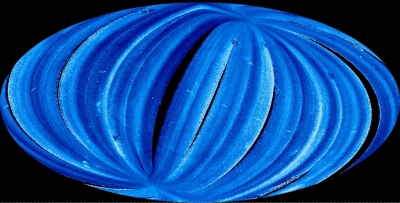Ultraviolet
| Wavelength range | m | 4×10-7 - 10-9 |
| Frequency range | Hz | 8×1014 - 3×1017 |
| Energy range | eV | 3 - 103 |
 |
|
This image is a composite of scans made by the Extreme Ultraviolet Explorer (EUVE) of many small strips covering the whole sky. The black strips are gaps in the data. |
ESA Missions
IUE
The International Ultraviolet Explorer (IUE) was operational from 1978 to 1996, making it the longest-lived astronomical satellite ever. It covered the wavelength region between 115 and 330 nm.
Hubble
The Hubble Space Telescope covers the energy range 0.1 to 2.5 µm, encompassing the entire optical part of the spectrum along with parts of both the ultraviolet and the infrared.
Sources of Ultraviolet radiation
- Stars: Hot O-type stars emit strongly in the ultraviolet part of the spectrum, as opposed to the optical part which is the region of the peak emission for most other stars.
- Interstellar medium: using the different spectral lines as a diagnostic, the UV lines provide information on the composition of the interstellar medium.
- Supernovae: material expelled by the super nova explosion is lit up by radiation from the remnant star.
- Active Galactic Nuclei
Last Update: 1 September 2019
